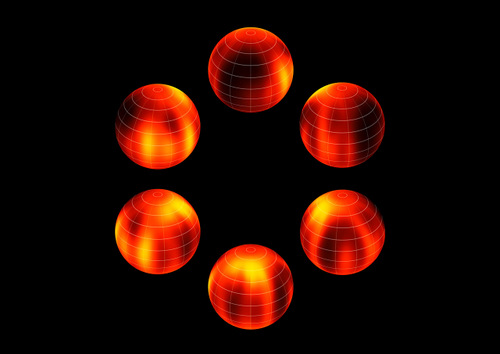Astronomers using a novel technique have mapped a brown dwarf's visible surface — even though they can't resolve the object in telescopes.
Just a few weeks ago, we reported one team's weather report for Luhman 16B, one of a newly discovered pair of brown dwarfs just 6.6 light-years from Earth. The team's observations showed a gargantuan version of the Giant Red Spot covering between 15% and 25% of the brown dwarf's visible surface.
Now two more teams are reporting additional observations, with one actually mapping out the weather patterns on the brown dwarf's visible surface.

Astronomers have mapped the dark and light features of the brown dwarf WISE J104915.57-531906.1B (aka Luhman 16B) using ESO's Very Large Telescope. The figure shows the object at six equally spaced times as it rotates once on its axis.
ESO / I. Crossfield
Ian Crossfield (Max Planck Institute for Astronomy, Germany) and colleagues mapped the brown dwarf's visible surface in a way similar to the way satellites map our own planet's weather. But unlike Earth, the brown dwarf lies too far away for astronomers to make out individual weather features. So they resorted to a sneaky workaround.
With a spectrograph on the Very Large Telescope the team monitored the brown dwarf's brightness throughout its 4.9-hour rotation while also measuring the light's Doppler shift. Taken together, the measurements told the astronomers whether any bright spot was moving toward or away from Earth, allowing them to create a detailed surface map. (For a good explanation of the method they used, see Max Planck's press release.)
An important note: it's likely that the bright spots in these surface maps are patchy clouds. But it's also possible that the spots could be due to changes in temperature or composition. Follow-up observations using the same technique but in different wavelength bands will be able to tell the difference.
The video below shows a rotating 3D version of the weather map by combining the VLT images:
Beth Biller (MPI, Germany, and University of Edinburgh, UK) and colleagues took a different view of the same object. Rather than measuring the Doppler shift of a single wavelength, they monitored Luhman 16B's brightness in a half dozen different wavelength filters. Each wavelength probes a different depth, so Biller's team was able to follow weather patterns at different altitudes, showing that the cloud formations extend beyond a single layer.
Being so close to Earth, Luhman 16B presents a convenient target for these kinds of techniques — Doppler imaging in particular can't be used on farther and fainter brown dwarfs. The discovery of Luhman 16B is proving to be a boon to observers and theorists alike.
Read more:
Max Planck Institute for Astronomy Press Release (Includes instructions for folding your own Luhman 16B origami balloon.)
European Southern Observatory Press Release
Beth Biller et al. "Weather on the Nearest Brown Dwarfs: Resolved Simultaneous Multi-wavelength Variability Monitoring of WISE J104915.57–531906.1AB." Astrophysical Journal, 20 November, 2013.
Ian Crossfield et al. "A cloudy forecast for a brown dwarf." Nature, 30 January 2014.
 3
3
Comments
Justin S
January 30, 2014 at 5:42 pm
It's interesting the the banding seems to be poleward rather then parallel to the equator.
You must be logged in to post a comment.
Anton Szautner
February 2, 2014 at 11:39 am
Justin, the longitudinal pattern is almost certainly an artifact of the method used to translate brightness variations mapped on a sphere. There may possibly be real limb-brightness enhancement effects which may complicate the situation and over-accentuate the longitudinal pattern. But the gross bright-dark regions should be regarded tentatively, as generally distributed.
You must be logged in to post a comment.
Mike W. Herberich
February 7, 2014 at 11:40 am
A shy counter-question, Anton: if what is visible in the video are mostly (exclusively?) artifacts, (1) why are (almost) only these shown in the video, in the first place? Or, put differently (2) what remains to be seen or shown if anything in the video is just an artifact? As I see it, almost everything is vertical there. At least, I can't make out anything along or parallel to the equator.
You must be logged in to post a comment.
You must be logged in to post a comment.